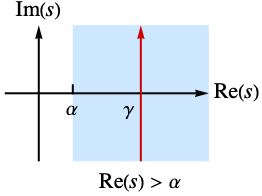InverseLaplaceTransform[F[s],s,t]
gives the symbolic inverse Laplace transform of F[s] in the variable s as f[t] in the variable t.
InverseLaplaceTransform[F[s],s,![]() ]
]
gives the numeric inverse Laplace transform at the numerical value ![]() .
.
InverseLaplaceTransform[F[s1,…,sn],{s1,s2,…},{t1,t2,…}]
gives the multidimensional inverse Laplace transform of F[s1,…,sn].




InverseLaplaceTransform
InverseLaplaceTransform[F[s],s,t]
gives the symbolic inverse Laplace transform of F[s] in the variable s as f[t] in the variable t.
InverseLaplaceTransform[F[s],s,![]() ]
]
gives the numeric inverse Laplace transform at the numerical value ![]() .
.
InverseLaplaceTransform[F[s1,…,sn],{s1,s2,…},{t1,t2,…}]
gives the multidimensional inverse Laplace transform of F[s1,…,sn].
Details and Options


- Laplace transforms are typically used to transform differential and partial differential equations to algebraic equations, solve and then inverse transform back to a solution.
- Laplace transforms are also extensively used in control theory and signal processing as a way to represent and manipulate linear systems in the form of transfer functions and transfer matrices. The Laplace transform and its inverse are then a way to transform between the time domain and frequency domain.
- The inverse Laplace transform of a function
 is defined to be
is defined to be  , where γ is an arbitrary positive constant chosen so that the contour of integration lies to the right of all singularities in
, where γ is an arbitrary positive constant chosen so that the contour of integration lies to the right of all singularities in  .
. - The multidimensional inverse Laplace transform of a function
 is given by a contour integral of the form
is given by a contour integral of the form  .
. - The integral is computed using numerical methods if the third argument
 is given a numerical value. The available method settings include "Crump", "Durbin", "Papoulis", "Piessens", "Stehfest", "Talbot" and "Weeks".
is given a numerical value. The available method settings include "Crump", "Durbin", "Papoulis", "Piessens", "Stehfest", "Talbot" and "Weeks". - The asymptotic inverse Laplace transform can be computed using Asymptotic.
- The following options can be given:
-
AccuracyGoal Automatic digits of absolute accuracy sought Assumptions $Assumptions assumptions to make about parameters GenerateConditions False whether to generate answers that involve conditions on parameters Method Automatic method to use PerformanceGoal $PerformanceGoal aspects of performance to optimize PrecisionGoal Automatic digits of precision sought WorkingPrecision Automatic the precision used in internal computations - In TraditionalForm, InverseLaplaceTransform is output using ℒ-1. »

Examples
open all close allBasic Examples (4)
Scope (56)
Basic Uses (3)
Compute the inverse Laplace transform of a function for a symbolic parameter t:
Use a numerical value for the parameter:
TraditionalForm formatting:
Rational Functions (5)
Elementary Functions (5)
Logarithmic Functions (4)
Special Functions (12)
Function involving BesselK:
Ratio of an incomplete gamma function and a power function:
Inverse of a polygamma function:
Inverse of a function involving an error function:
Error function composed with a square root:
Inverse transforms of the LegendreP and LegendreQ functions:
Complex plots of the Legendre functions:
ComplexPlot of the frequency-domain function:
Product of BesselJ and Gamma functions:
ComplexPlot of the frequency-domain function:
Composition of exponential integral and square root functions:
Product of two ParabolicCylinderD functions:
Inverse transforms involving elliptic integral functions:
Inverse transform of EllipticTheta:
Piecewise Functions (5)
Periodic Functions (4)
Generalized Functions (3)
Multivariate Functions (8)
Inverse Laplace transform of a bivariate rational function:
Rational function that is separable with respect to p and q:
Rational function that is not separable with respect to p and q:
Rational function whose inverse is related to BesselJ:
Inverse Laplace transform of a bivariate function involving a radical:
Inverse Laplace transform of a multivariate function in three variables:
Numerical Inversion (4)
Calculate the inverse Laplace transform at a single point:
Alternatively, calculate the inverse Laplace transform symbolically:
Then evaluate it for a specific value of t:
Plot the inverse Laplace transform numerically and compare it with the exact result:
Function whose inverse is a piecewise function with respect to t:
Function whose inverse is a periodic function with respect to t:
Fractional Calculus (3)
ComplexPlot of an algebraic function in the ![]() -domain:
-domain:
Inverse Laplace transform of this algebraic function:
Laplace transform to the ![]() -domain:
-domain:
Inverse Laplace transform of the algebraic function:
Laplace transform to the ![]() -domain:
-domain:
Inverse Laplace transform of the algebraic function involving parameters:
Options (3)
GenerateConditions (1)
By default, InverseLaplaceTransform assumes that the result is defined for non-negative t:
Use GenerateConditions to obtain the range of validity for the result:
Method (1)
Use the default method for numerical evaluation:
Use Method to obtain the result from different methods:
Working Precision (1)
Use WorkingPrecision to obtain a result with arbitrary precision:
Applications (5)
Compute the step response to the linear system with transfer function ![]() :
:
Solve a differential equation using Laplace transforms:
Solve for the Laplace transform:
Find the solution directly using DSolve:
Solve a fractional-order differential equation of order 3/2:
Solve for the Laplace transform:
Find the solution directly using DSolve:
Solve a fractional-order differential equation of order 21/10:
Solve for the Laplace transform:
Find the solution directly using DSolve:
Solve a system of fractional DEs using LaplaceTransform:
Properties & Relations (2)
Use Asymptotic to compute an asymptotic approximation:
InverseLaplaceTransform and LaplaceTransform are mutual inverses:
Neat Examples (2)
Related Guides
Related Links
History
Introduced in 1999 (4.0) | Updated in 2020 (12.2) ▪ 2023 (13.3)
Text
Wolfram Research (1999), InverseLaplaceTransform, Wolfram Language function, https://reference.wolfram.com/language/ref/InverseLaplaceTransform.html (updated 2023).
CMS
Wolfram Language. 1999. "InverseLaplaceTransform." Wolfram Language & System Documentation Center. Wolfram Research. Last Modified 2023. https://reference.wolfram.com/language/ref/InverseLaplaceTransform.html.
APA
Wolfram Language. (1999). InverseLaplaceTransform. Wolfram Language & System Documentation Center. Retrieved from https://reference.wolfram.com/language/ref/InverseLaplaceTransform.html
BibTeX
@misc{reference.wolfram_2025_inverselaplacetransform, author="Wolfram Research", title="{InverseLaplaceTransform}", year="2023", howpublished="\url{https://reference.wolfram.com/language/ref/InverseLaplaceTransform.html}", note=[Accessed: 03-January-2026]}
BibLaTeX
@online{reference.wolfram_2025_inverselaplacetransform, organization={Wolfram Research}, title={InverseLaplaceTransform}, year={2023}, url={https://reference.wolfram.com/language/ref/InverseLaplaceTransform.html}, note=[Accessed: 03-January-2026]}